目錄
match
匹配字符串
單字符匹配
. 匹配任意一個字符
d 匹配數字
D 匹配非數字
s 匹配特殊字符,如空白,空格,tab等
S 匹配非空白
w 匹配單詞、字符,如大小寫字母,數字,_ 下劃線
W 匹配非單詞字符
[ ] 匹配[ ]中列舉的字符
表示數量
?* 出現0次或無數次
+ 至少出現一次
? 1次或則0次
{m}指定出現m次
{m,} 至少出現m次
{m,n} 指定從m-n次的范圍
匹配邊界
$ 匹配結尾字符
^ 匹配開頭字符
匹配一個單詞的邊界
B 匹配非單詞邊界
匹配分組
| 匹配左右任意一個表達式
(ab) 將括號中字符作為一個分組
search
findall
re.s
sub
split
貪婪與非貪婪
案例
匹配手機號
提取網頁源碼中所有的文字
?提取圖片地址
正則表達式是對字符串提取的一套規則,我們把這個規則用正則裡面的特定語法表達出來,去匹配滿足這個規則的字符串。正則表達式具有通用型,不僅python裡面可以用,其他的語言也一樣適用。
python中re模塊提供了正則表達式的功能,常用的有四個方法(match、search、findall)都可以用於匹配字符串
**re.match()必須從字符串開頭匹配!**match方法嘗試從字符串的起始位置匹配一個模式,如果不是起始位置匹配成功的話,match()就返回none。主要參數如下:
re.match(pattern, string)
# pattern 匹配的正則表達式
# string 要匹配的字符串
例子
import re
a = re.match('test','testasdtest')
print(a) #返回一個匹配對象
print(a.group()) #返回test,獲取不到則報錯
print(a.span()) #返回匹配結果的位置,左閉右開區間
print(re.match('test','atestasdtest')) #返回None

從例子中我們可以看出,re.match()方法返回一個匹配的對象,而不是匹配的內容。如果需要返回內容則需要調用group()。通過調用span()可以獲得匹配結果的位置。而如果從起始位置開始沒有匹配成功,即便其他部分包含需要匹配的內容,re.match()也會返回None。
以下字符,都匹配單個字符數據。且開頭(從字符串0位置開始)沒匹配到,即使字符串其他部分包含需要匹配的內容,.match也會返回none
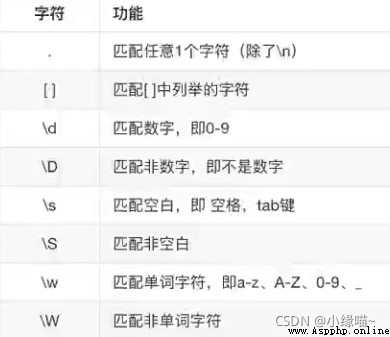
使用幾個點號就代表幾個字符
import re
a = re.match('..','testasdtest')
print(a.group()) #輸出te
b = re.match('ab.','testasdtest')
print(b) #返回none,因為表達式是以固定的ab開頭然後跟上通配符. 所以必須要先匹配上ab才會往後進行匹配

一個d代表一個數字。開頭沒匹配到,即使字符串其他部分包含需要匹配的內容,.match也會返回none
import re
a = re.match('dd','23es12testasdtest')
print(a)
b = re.match('ddd','23es12testasdtest')
print(b) #要求匹配三個數字,匹配不到返回none
c = re.match('d','es12testasdtest')
print(c) #起始位置沒有匹配成功,一樣返回none

開頭沒匹配到,即使字符串其他部分包含需要匹配的內容,.match也會返回none
import re
a = re.match('D','23es12testasdtest')
print(a) #開頭為數字所以返回none
b = re.match('DD','*es12testasdtest')
print(b) #返回*e
import re
print(re.match('s',' 23es 12testasdtest')) #匹配空格
print(re.match('s',' 23es 12testasdtest')) #匹配tab
print(re.match('s','
23es 12testasdtest')) #匹配
換行
print(re.match('s','23es 12testasdtest')) #返回none

import re
print(re.match('S',' 23es 12testasdtest')) #返回none
print(re.match('S','
23es 12testasdtest')) #none
print(re.match('S','23es 12testasdtest'))

import re
print(re.match('w','23es 12testasdtest')) #返回none
print(re.match('www','aA_3es 12testasdtest')) #返回none
print(re.match('www','
12testasdtest')) #返回none

import re
print(re.match('W','23es 12testasdtest')) #返回none
print(re.match('W',' 23es 12testasdtest')) #匹配空格

只允許出現[ ]中列舉的字符
import re
print(re.match('12[234]','232s12testasdtest')) #因為開頭的12沒匹配上,所以直接返回none
print(re.match('12[234]','1232s12testasdtest')) #返回123

[^2345] 不匹配2345中的任意一個
import re
print(re.match('12[^234]','232s12testasdtest')) #因為開頭的12沒匹配上,所以直接返回none
print(re.match('12[^234]','1232s12testasdtest')) #返回none
print(re.match('12[^234]','1252s12testasdtest')) #返回125
[a-z3-5] 匹配a-z或者3-5中的字符
import re
print(re.match('12[1-3a-c]','1232b12testasdtest')) #123
print(re.match('12[1-3a-c]','12b2b12testasdtest')) #12b
print(re.match('12[1-3a-c]','12s2b12testasdtest')) #返回none
像上面寫的那些都是匹配單個字符,如果我們要匹配多個字符的話,只能重復寫匹配符。這樣顯然是不人性化的,所以我們還需要學習表達數量的字符
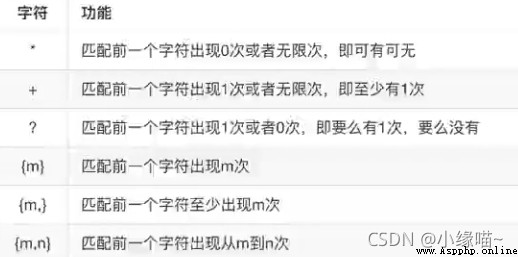
import re
a = re.match('..','testasdtest')
print(a.group()) #輸出te
a = re.match('.*','testasdtest')
print(a.group()) #全部輸出

import re
print(re.match('a*','aatestasdtest')) #匹配跟隨在字母a後面的所有a字符
print(re.match('d*','23aatestasdtest')) #匹配前面為數字的字符
print(re.match('ad*','ad23aatestasdtest')) #輸出a, 因為*也可以代表0次

import re
print(re.match('a+','aaatestasdtest')) #匹配前面為字母a的字符,且a至少有1一個
print(re.match('a+','atestasdtest')) #a
print(re.match('a+','caaatestasdtest')) #none

import re
print(re.match('a?','abatestasdtest')) #匹配a出現0次或者1次數
print(re.match('a?','batestasdtest')) #輸出空,因為a可以為0次
print(re.match('a?','aaatestasdtest')) #a出現0次或者1次,輸出1個a

import re
print(re.match('to{3}','toooooabatestasdtest')) #匹配t以及跟隨在後面的三個ooo
print(re.match('to{3}','tooabatestasdtest')) #只有兩個0,返回none

import re
print(re.match('to{3,}','toooooabatestasdtest')) #匹配t以及跟隨在後面的三個ooo至少出現3次
print(re.match('to{3,}','tooabatestasdtest')) #只有兩個0,返回none

import re
print(re.match('to{3,4}','toooabatestasdtest')) #剛好有三個ooo,成功匹配
print(re.match('to{3,4}','tooabatestasdtest')) #只有兩個o,返回none
print(re.match('to{3,4}','toooooabatestasdtest')) #提取最多四個o

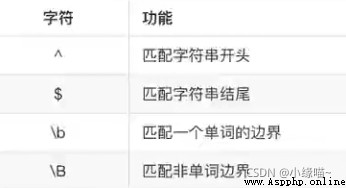
定義整個字符串必須以指定字符串結尾
import re
print(re.match('.*d$','2testaabcd')) #字符串必須以d結尾
print(re.match('.*c','2testaabcd')) #字符串不是以c結尾,返回none

定義整個字符串必須以指定字符開頭
import re
print(re.match('^2','2stoooabatestas')) #規定必須以2開頭,否則none
print(re.match('^2s','2stoooabatestas')) #必須以2s開頭
:表示字母數字與非字母數字的邊界,非字母數字與字母數字的邊界。即下面ve的右邊不能有字母和數字
import re
print(re.match(r'.*ve','ve.2testaabcd')) #因為在python中代表轉義,所以前面加上r消除轉義
print(re.match(r'.*ve','ve2testaabcd'))

import re
print(re.match(r'.*veB','2testaavebcdve')) #ve的右邊需要有字母或者數字
print(re.match(r'.*veB','2testaave3bcdve'))

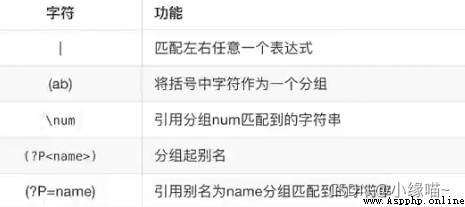
只要|兩邊任意一個表達式符合要求就行
import re
print(re.match(r'd[1-9]|D[a-z]','2233')) #匹配|兩邊任意一個表達式
print(re.match(r'd[1-9]|D[a-z]','as'))

()中的內容會作為一個元組字符裝在元組中
import re
a = re.match(r'<h1>(.*)<h1>','<h1>你好啊<h1>')
print(a.group()) #輸出匹配的字符
print(a.groups()) #會將()中的內容會作為一個元組字符裝在元組中
print('`````````````')
b = re.match(r'<h1>(.*)(<h1>)','<h1>你好啊<h1>')
print(b.groups()) #有兩括號就分為兩個元組元素
print(b.group(0)) #group中默認是0
print(b.group(1)) #你好啊
print(b.group(2)) #h1
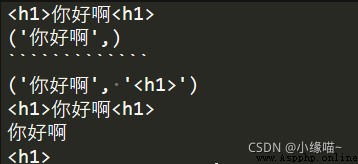
和match差不多用法,從字符串中進行搜索
import re
print(re.match(r'dd','123test123test'))
print(re.search(r'dd','123test123test'))

從字面意思上就可以看到,findall是尋找所有能匹配到的字符,並以列表的方式返回
import re
print(re.search(r'test','123test123test'))
print(re.findall(r'test','123test123test')) #以列表的方式返回

findall中另外一個屬性re.S
在字符串a中,包含換行符 ,在這種情況下
如下要尋找test.*123的數據,因為test和123在不同的行,如果沒加re.s的話,他會在每一個進行匹配查找而不是將字符串作為一個整體進行查找
import re
a = """aaatestaa
aaaa123"""
print(re.findall(r'test.*123',a))
print(re.findall(r'test.*123',a,re.S))

查找字符串中所有相匹配的數據進行替換
sub(要替換的數據,替換成什麼,要替換的數據所在的數據)
import re
print(re.sub('php','python','php是世界上最好的語言——php'))
#輸出 "python是世界上最好的語言——python"
對字符串進行分割,並返回一個列表
import re
s = "itcase,java:php-php3;html"
print(re.split(r",",s)) #以,號進行分割
print(re.split(r",|:|-|;",s)) #以,或者:或者-或者;進行分割
print(re.split(r",|:|-|%",s)) #找不到的分隔符就忽略

python裡的數量詞默認是貪婪的,總是嘗試盡可能的匹配更多的字符。python中使用號關閉貪婪模式
如
import re
print(re.match(r"aad+","aa2323")) #會盡可能多的去匹配d
print(re.match(r"aad+?","aa2323")) #盡可能少的去匹配d

import re
s = "this is a number 234-235-22-423"
# 1.貪婪模式
resule = re.match(r"(.+)(d+-d+-d+-d)",s) #我們本想數字和字母拆解成兩個分組
print(resule.groups()) #('this is a number 23', '4-235-22-4')但我們發現輸出的結果中23的數字竟然被弄到前面去了
#因為+它會盡可能多的進行匹配,d,只需要一個4就能滿足,所以前面就盡可能多的匹配
# 2.關閉貪婪模式
#在數量詞後面加上 ?,進入非貪婪模式,盡可能少的進行匹配
result = re.match(r"(.+?)(d+-d+-d+-d)",s)
print(result.groups()) #('this is a number ', '234-235-22-4')

要求,手機號為11位,必須以1開頭,且第二個數字為35678其種一個
import re
result = re.match(r'1[35678]d{9}','13111111111')
print(result.group()) #匹配成功
result = re.match(r'1[35678]d{9}','12111111111')
print(result) #none,第二位為2
result = re.match(r'1[35678]d{9}','121111111112')
print(result) #none,有12位

如下,將其中的所有文字提取出來,去掉標簽。思路就是運用sub方法,將標簽替換為空
s = """<div>
<p>崗位職責:</p>
<p>完成推薦算法、數據統計、接口、後台等服務器端相關工作</p>
<p><br></p>
<P>必備要求:</p>
<p>良好的自我驅動力和職業素養,工作積極主動、結果導向</p>
<p> <br></p>
<p>技術要求:</p>
<p>1、一年以上 Python開發經驗,掌握面向對象分析和設計,了解設計模式</p>
<p>2、掌握HTTP協議,熟悉NVC、MVVM等概念以及相關wEB開發框架</p>
<p>3、掌握關系數據庫開發設計,掌握SQL,熟練使用 MySQL/PostgresQL中的一種<br></p>
<p>4、掌握NoSQL、MQ,熟練使用對應技術解決方案</p>
<p>5、熟悉 Javascript/cSS/HTML5,JQuery,React.Vue.js</p>
<p> <br></p>
<p>加分項:</p>
<p>大數據,數理統計,機器學習,sklearn,高性能,大並發。</p>
</div>"""
要提取出來最重要的就是關閉貪婪模式,
result = re.sub(r'<.*?>| ','',s) #
print(result)
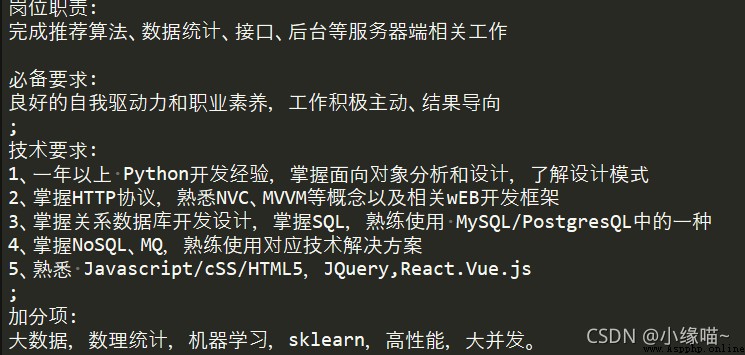
如果關閉貪婪模式,中的內容會盡可能多的匹配,只要能夠滿足後面的>就行,然後<>xxx<>中xxx內容也替換掉了
import re
s = """<img data-original="https://img02.sogoucdn.com/app/a/100520024/36189693dc8db6bd7c0be389f8aaddbd.jpg" src="https://img02.sogoucdn.com/app/a/100520024/36189693dc8db6bd7c0be389f8aaddbd.jpg" width="250" height="375" .jpg>"""
result1 = re.search(r"src="https.*.jpg"",s)
print(result1.group())
result2 = re.search(r"src="(https.*.jpg)"",s) #我只是想將網址提取出來,所以httpxx加括號,這樣我就可以把它單獨提取出來,src則不會出來
print(result2.groups()[0])

先自我介紹一下,小編13年上師交大畢業,曾經在小公司待過,去過華為OPPO等大廠,18年進入阿裡,直到現在。深知大多數初中級java工程師,想要升技能,往往是需要自己摸索成長或是報班學習,但對於培訓機構動則近萬元的學費,著實壓力不小。自己不成體系的自學效率很低又漫長,而且容易碰到天花板技術停止不前。因此我收集了一份《java開發全套學習資料》送給大家,初衷也很簡單,就是希望幫助到想自學又不知道該從何學起的朋友,同時減輕大家的負擔。添加下方名片,即可獲取全套學習資料哦